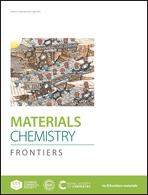Synergistic improvements in the performance and stability of inverted planar MAPbI3-based perovskite solar cells incorporating benzylammonium halide salt additives†
Abstract
In this study, three different benzylammonium halide (Cl, Br, and I) salts were investigated to elucidate their effects as additives on MAPbI3 perovskite surface morphology, crystal structure, optical properties, and solar cell performance and stability. In particular, the additive benzylammonium chloride (BZACl) has a cationic benzylammonium (BZA) ion as a surface capping ligand and exhibits stronger electronegativity attributed to anionic Cl− ions for suppressing the defect formation of iodine vacancies. The study demonstrated that most effectively reducing the defects and suppressing non-radiative recombination result in a significant increase in the photoluminescence (PL) intensity and lifetime of BZACl-doped MAPbI3 thin films. By optimizing the concentration of BZACl to about 0.27 mol% relative to MAPbI3, the corresponding device exhibited a maximum power conversion efficiency (PCE) of 19.8%, with negligible hysteresis (PCE = 20.4% in reverse scan), in comparison with the PCE of 17.8% for the control device with pristine perovskite films. In addition, excellent moisture stability is demonstrated with 90% retainment of the initial efficiency after 30 days of unencapsulated operation under ambient air conditions (∼45% relative humidity). This work highlights the great potential of benzylammonium halide salts as additives for developing high-efficiency and simultaneously stable MAPbI3-based perovskite solar cells.



 Please wait while we load your content...
Please wait while we load your content...